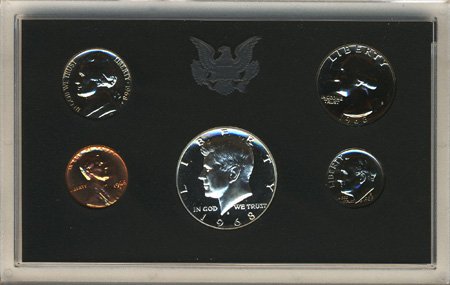Guide to U.S. Mint Proof Sets
The annual Proof Set has been a long time favorite for coin collectors. It provides a simple and affordable way to collect an example of each coin issued by the United States Mint for the year in high quality Proof condition.

Proof coinage is created through a special process which creates brilliant coins with sharp relief. In general, the process involves polishing the blanks used in production and striking them multiple times with specially polished dies. Most modern Proof coins exhibit cameo features. The raised elements of the coin design appear frosted, while the background fields appear mirrored. For early Proof coins, this type of finish is less common or scarce, making cameo and deep cameo examples highly desirable.
The Modern Era
The era of modern Proof coinage is generally considered to have started in 1936. That year, the Philadelphia Mint resumed production of Proof coins after a twenty year gap. The Proof coins were struck for each circulating denomination and sold to the public from 1936 to 1942 inclusive. At the time, the coins could be purchased either individually or as a complete set.
There was another pause in the production of Proof coinage after 1942. Production would resume in 1950 when the US Mint would resume sales of Proof coins as complete sets which contained one coin for each denomination. The Proof sets from 1950 to 1955 were packaged in individual cellophane slips, stapled together at the top, and placed into a cardboard box.
In 1955, the packaging was changed to a new flat pack, which would be used until 1964. This type of packaging placed the coins in a single cellophane film, with each coin in a separate compartment. This was placed within a printed United States Mint mailing envelope.
From 1965 to 1967, the U.S. Mint temporarily replaced Proof Sets with Special Mint Sets. The coins in these sets had Proof like qualities, which made them superior to regular coins struck for circulation.
Starting with 1968, the Proof Set assumed its most familiar format. Coins were sealed within a rigid plastic holder and placed within a box. Although the design of the holder and box would change over the years, this basic format is still used today.

